Hash (hashish) is one of the most potent cannabis derivatives, with high concentrations of THC. Since it’s now widely available around the world, I decided to create an all-encompassing, encyclopedic online hash manual.
So here’s what you’ll learn today:
- What is hash
- Origins of hash
- How is modern hash made
- What are the different types of hash
- What does a hash high feel like
- How potent is hash
- How long does a hash high last
- How to make hash from weed at home
- How to smoke hash
We have a lot to cover so let’s get started.
What exactly is hash?
Hash (or hashish) is a drug made from cannabis. To be precise, hash is a type of marijuana concentrate that is made by separating resin glands from the flowers.
Resin glands are alsow known as trichomes.
Trichomes grow on top of female flowers and sugar leaves and they contain the biggest amounts of cannabinoids and terpenes.
Cannabinoids are the active chemical compounds in cannabis which modulate our endocannabinoid system, and create a variety of psychoactive and medicinal effects.
Making hash from cannabis revolves around separating trichomes from the plant and merging them into a whole, either by just pressure or by using other more sophisticated techniques.

A close up of trichomes on a cannabis plant. Image credit: ZenPype
Trichomes look like miniature mushroom-like nodules.
Trichomes that are extracted from the plant and are left bunched together also form a product of its own—kief—which later gets turned into hash.
Origins of hash
Because hash cannot be made without cannabis, separating the history of hash from the history of cannabis can be somewhat difficult.
The name hashish (hash for short) comes from the Arabic word حشيش, which means grass.
The northern part of India has a long lasting tradition of consuming charas, which is their term for hash.
Because cannabis indica used to grow wild in this area, it’s not hard to imagine that they figured out a way to incorporate hash in their religious and medicinal practices very early on.
From India, hash was introduced to the Arabian peninsula during the 10th century, and Europe followed suit somewhere at the beginning of the 18th century.
The widespread use of hash in Europe was facilitated by some notable members of the high society at the time, most notably Club des Hashischins, which included some pretty big players from the literary world from the era, such as Alexandre Dumas, Charles Baudelaire, Victor Hugo and Honoré de Balzac.
They experimented with hash (and other opiates like opium), to evaluate the effects of these substances on creativity.
Fast forward to the 20th century, Morocco became renowned for its hash quality.
And as the first hippie vagabonds came marching into the country in the 1960’s, the manufacturers also jumped on this newfound business opportunity.
Currently, the biggest producer of hash in the world is Afghanistan, but countries where medicinal and recreational cannabis is now legal have also seen a rapid increase of hash production.
How is modern hash made?
Hash certainly came a long way since it’s humble roots, with several very technically advanced patents being created in the last few decades.
While the countries where cannabis is illegal still use the ancient techniques of heat and pressure, where the collected resin of trichomes is heated and a press is used to create solid bricks of hash, during the 1980’s an ingenious invention was created.
The “Master Sifter”, created by John Gallardi, uses vibrations to remove trichomes from the plant. It also has several mesh screen filters of different sizes (measured in microns) which can easily filter all plant residue, while capturing the precious resin.
This machine made the entire process of making hash much faster, as the trichomes didn’t have to be separated from the plant by hand.
Hash also became much purer as the amount of plant residue was considerably decreased—the mesh screen filters keep any non-trichome material from falling into the mix.
Roughly at the same time, Rob Clarke and Neil Schumacher started dabbling with water extraction techniques.
Their prototype was a precursor of a method we now call the Ice Water Extract (or IWE in short).
Since then, the Ice Water Extract technique was upgraded by Marcus “Bubbleman” Richardson, and only several manufacturers have a permission to use his patented technology.
What are the different types of hash?
Bubble Hash

Image credit: Canada’s Finest Emoji OG
One of the world’s most popular types of hash is bubble hash, colloquially known as ice water hash.
Bubble hash is made through a process called ice water extraction, which uses cold water to separate trichomes from the flowers. The mix is then sifted through several screens.
When made with quality flowers, bubble hash has around 70% to 80% THC and is extremely potent.
Its color ranges from light to very dark brownish hues.
Lebanese Hash
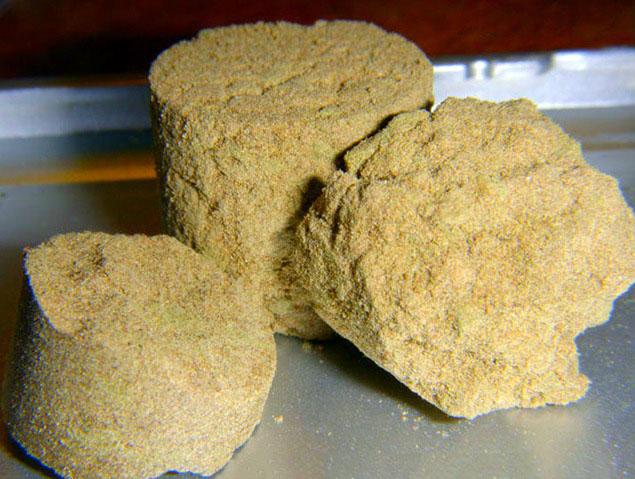
The manufacturing of this hash starts with the growers drying their flowers for an extended period of time.
The plants are then moved into a dry room, where they dry even more. After this they get rubbed with a fine fabric which collects all the precious resin from the plants.
The kief is then left to settle, after which it’s pressed into standardized slabs (bricks) of hash.
It’s not unusual for the manufacturers of Lebanese Hash to emboss their symbols on the slabs, which is meant to signal the quality of the product.
Afghani Royal (aka Royal Border) Hash
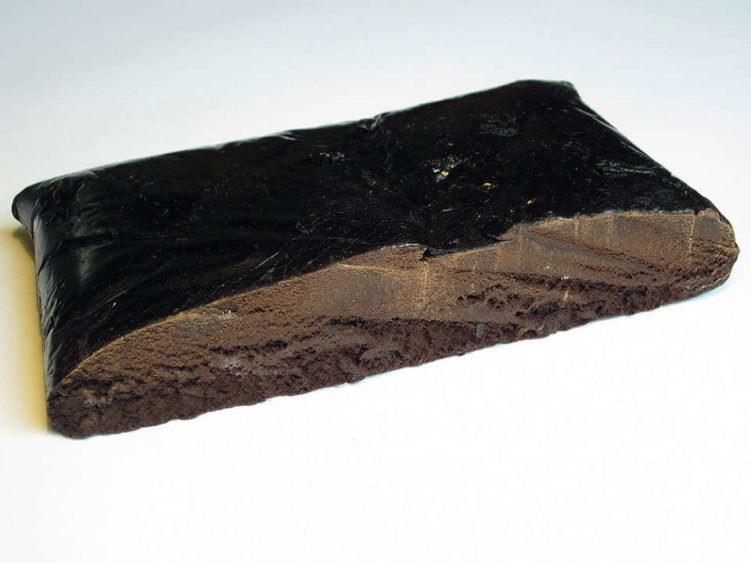
As I’ve previously mentioned, Afghanistan is one of the world’s biggest producers of hashish, and these types are made from landrace indica strains.
Afghan hash is made by placing the buds in water or tea for trichome separation, and the resin is then pressed into slabs or ball-like shapes.
This type of hash is usually dark brown on the outside and light brown on the inside.
Charas Hash
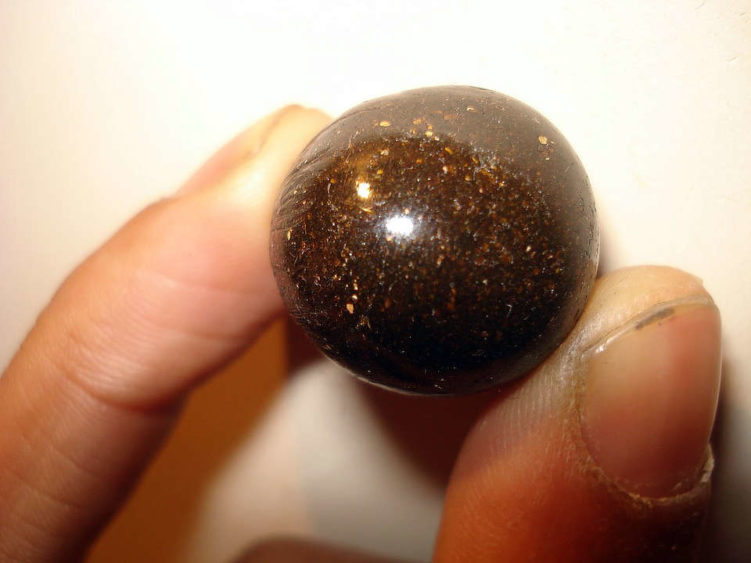
Image source: wikipedia.org
This type of hash originated in India, and it’s very closely linked with hinduistic practices in northern India.
They make this hash by hand, which is the most time consuming (and quite tedious) way of making hash.
Charas is very similar to Afghan hash by appearance and is mostly sold in ball or hot-dog-like shapes.
Super Nepalese Hash
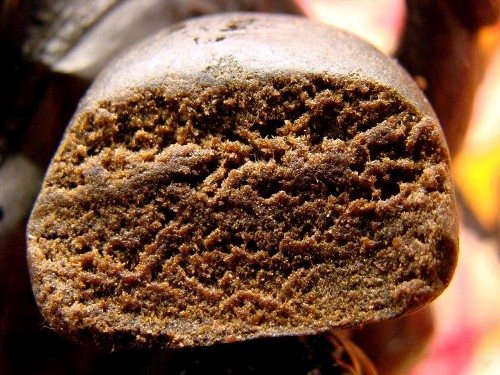
As the name suggest, this hash originated in Nepal and is made from cannabis indica strains.
It’s also mostly hand-made, which (similar to the Charas hash) makes it very soft and gooey.
It’s very difficult to find this product nowadays, but if you get a chance to try it, make sure you do because it’s truly exquisite.
Moroccan Slate Hash
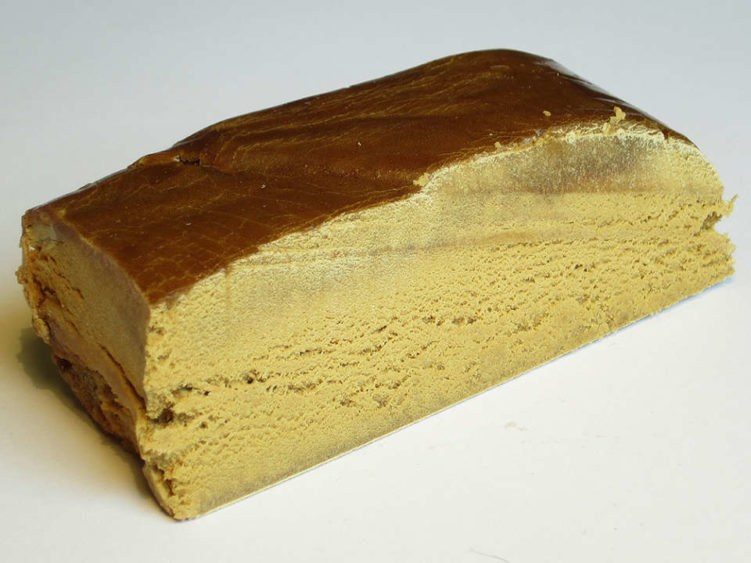
Morocco’s finest.
This type of hash is usually made in northern parts of Morocco, mostly in the Ketama region.
Slate hash is lightly aromatic, and not particularly potent compared to other popular types. It tastes quite mellow, and it’s not hard on the lungs. Its color ranges from green to light brown.
How does a hash high feel like?
As the main ingredient of hash is kief (an extremely potent trichome resin), the high will depend on the unique combination of cannabinoids and terpenes in the strain used for making it.
So, for example, if a hash has a lot of limonene (these types of hash usually have citrusy names like “Lemon Hash”), it will most likely make you cerebral, uplifted and motivated to tackle the day.
Hash made from indica-dominant strains generally contains more myrcene, which is why it produces more of a body-type of high.
Compared to regular cannabis flowers, hash is generally considered more mellow, and the high from it lasts shorter.
Many users also report a much “clearer head” from the hash high in comparison to regular buds, which leaves room for performing various creative activities.
How potent is hash?
Hash is much more potent than regular cannabis flowers because it’s made out of trichomes which contain most of the plant’s cannabinoids.
The exact potency of hash depends on how it was made and the flowers that were used.
The first factor is definitely the potency of cannabis that was used for the creation of kief, so if you have a potent flower (let’s say about 20% THC), the hash that you make from it will be much more potent than when using low-potency weed.
Another key factor is the production method.
For instance, using a standard grinder that has a sifter for kief, and later using this kief for hash production (which will have a lot of plant residue in comparison to the other techniques), will result in a hash that has medium potency, around 30% to 50% THC.
If you were to use the “Master Sifter” machine, the kief would be much purer, resulting in a more potent end-product, around 40% to 60% THC.
Currently the best possible technique for kief separation is the Ice Water Extraction method. Trichomes separate much better when they’re frozen.
With this method, you can get kief with up to 80% THC.
How long does a hash high last?
The duration of the hash high depends on the amount consumed and your tolerance to THC, but it’s safe to say that a high from hash generally lasts around 45 minutes to an hour.
Unlike smoking, hash-infused edibles take a while longer to kick in (anywhere from 30 to 60 minutes), and the high can last up to 6 hours.
Edibles are generally better suited for medicinal consumers, because of the elongated duration of the effects.
How to make hash from weed at home (2 methods)
There are a couple of very low-budget ways to make your own hash at home.
Method #1: Hand rolling hash
The first one is the simplest, but it also requires the most work.
This ancient technique is still used in some parts of Nepal and India, and the trick is to roll the fresh buds in the palms of your hands until your hands become sticky.
Make sure that your hands are clean and avoid placing too much pressure on the flower.
After 10-15 minutes you’ll start seeing a thick dark layer of resin covering your palms and fingers.
The next step is just to scrape the residue from your hands with a hard-surfaced object. You can use a ruler or something similar, just make sure that it’s not too sharp.
Once you’ve removed the resin from your hands, form it into a ball or roll it into a worm-like shape that you can easily place in your joint/blunt.
Method #2: Pressing the kief into blocks
Using a grinder that has a separate chamber for collecting kief is the first step in creating your own hash-blocks.
You can also use a “Master Sifter” silk screening method, or the Ice Water Extraction bags, but these options are much pricier, so if you’re doing this just for fun or experimentation (and not sale), I recommend you use a grinder, at least at first.
Technique 1—Press
Once you’ve collected enough kief in your grinder chamber, you can turn it into hash using a press made for this specific task.
This method is quite simple—just load the kief into your press, and depending on if it’s a twist-press or a hammer-type one, twist or hammer it until you’ve achieved optimal pressure.
I also recommend you leave your newly created hash in the press for at least 24 hours (or even longer).
Technique 2—The oven
This one is a bit more complicated, but luckily it doesn’t require anything you already don’t have in your household.
Place your kief in cellophane and make sure to make it completely waterproof.
Wrap this cellophane bundle in wet newspapers so the package doesn’t get damaged from direct exposure to heat.
Preheat your oven to 160°C and place your wrapped kief in it for 10 minutes.
Once you’ve taken the package out of the oven, place it on a heatproof surface and press and spread your kief with a rolling pin.
To create a perfectly firm and evened out hash, repeat these steps a couple of times.
Once finished, place your DIY hash in the fridge to cool overnight.
How to smoke hash?
There are a couple of different ways you can get hash into your system.
1) Add it to your spliff
This is the most common way of smoking hash, and it’s customary in most parts of Europe.
The premise is that you roll a joint with tobacco (this means without any pot) and just sprinkle some hash on top, before you start closing the joint.
2) The Glass method
This technique only applies if you have a clay-like hash that is easy to manipulate.
You’ll need a regular water glass, a cigarette, a straw and a hash “worm”.
Take a cigarette, and drill a tiny hole in the middle of it (you can use a pen or anything else that has a small dagger-like tip, for instance scissors).
Put your hash worm into the hole you’ve drilled in the cigarette, so the biggest part of it just suspends freely.
Depending on the size of your glass, cut your cigarette so it can suspend itself on the diameter of your glass.
Light the lower tip of your worm (the furthest part from the cigarette), turn the glass upside down, and place it onto the table. You’ll see how the smoke slowly fills up the glass as the worm slowly incinerates.
Once thick smoke fills the glass, lift one side of the glass up and inhale the content of the glass with a straw.
Just make sure when you light you worm not to leave it flaming, but instead you want to have a small ember, burning gently and evenly.
You might be concerned that this method burns the hash too quickly, but in fact it’s a very economical way to use hash.
3) Use a vaporizer
The most health-friendly way of consuming any cannabis product (besides edibles) is vaping.
Cannabis vaporizers work by heating your hash to temperatures at which all active compounds are released without combustion.
Because hash is denser than any regular cannabis, you should use a vape that has temperature control and set it to around 190°C.

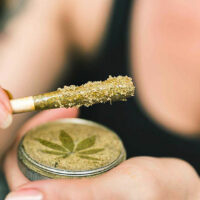

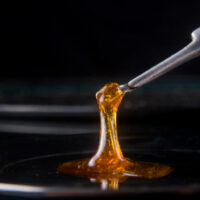
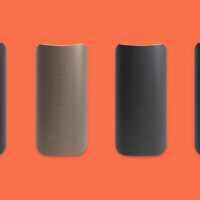

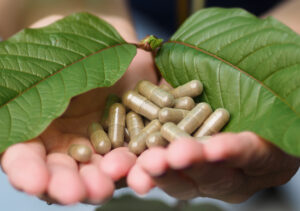
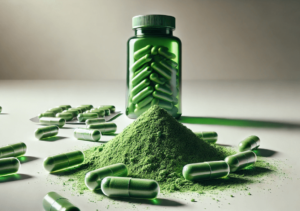

Terry February 9, 2019 at 7:54 pm
Any advice on baking hash into brownies? I dislike smoking it and was hoping to make a butter with my afghan black hash but am not sure how to break it down. I've baked with Marijuana before, making a butter but am not sure about how to proceed with a chunk of black hash. Any suggestions? Great site btw!
Marco February 11, 2019 at 9:58 am
Hey Terry, you should check out this article https://wakeandbake.co/hash-butter/ Corinne explains everything nicely, and thanks for the kind words :)
HashHead February 28, 2019 at 3:42 pm
Very nice article. There is also another way to smoke hash in a cigarette: You get a rather dry cigarette. if you live in humid places you can put your cigarette on a heater for couple of minutes or warm up the cigarette with a lighter without burning it, then puff on it and it gets dry. First you put your hash on a piece of thin stick so you can bake it later. Second, empty the cigarette tobacco in your palm or a piece of paper. Reduce the amount of tobacco by removing big pieces. Now its time to bake the hash. Depending on type of hash you got, you need to bake it with direct flame without letting it catch fire for at least 15 seconds to a minute. Then drop the hash on tobacco and try to mix them together. Baking turns the solid texture of hash into a powder. They get completely mixed together in a way that is hard to see any small part of hash after you tweak with the baking time and process. Last but not least you load the mixture back to the cigarette and your joint is ready.
Marco March 4, 2019 at 9:48 am
Thank you for your input HashHead, we appreciate it.
Paul Johnston March 14, 2019 at 5:34 pm
I've been a major fan of hashish since I tried some Nepalese finger hash back in around 1982 that my school mate's brother carried home from a visit to Nepal. Lucky enough to have a really close match from a cannabis producer in the Seattle area called Sitka, they produce a wonderful Lebanese Red hash that is sublime. It produces a "heavy sedative buzz" just like I remember from the Nepalese stuff. Good article, very informative.
Marco March 15, 2019 at 10:10 am
Thanks for letting us know Paul, that Lebanese Red sounds yummy!
Misty Matthews February 24, 2020 at 5:59 pm
What about mixing the powder into coconut oil? And can you use it topically for pain.
Marco Medic February 25, 2020 at 10:16 am
That could also work😏
Scarlett of the Creek November 7, 2020 at 5:50 pm
Hey there...two questions. But first, thanks for a nearly crystal clear article that is written so well that this 100% newbie mostly understood. I was just introduced to hash for the first time; I am pretty sure I've only even said the word "hash" twice in 52 years. So, forgive me if my questions are dumb. 1. The product I have is the clay type you mentioned, but mine is hard and I can't manipulate it. I tried to cut a piece off of the chunk I have and I needed a chisel cos the knife blade would've snapped. Does this mean I have bad stuff? Too old and stale, or prepared wrong? 2. Is there an image or diagram of your second technique somewhere? I can't make my brain see the cig with a hole filled by a hash worm suspended over a glass, that gets flipped...I think the worm in the hole is throwing me. If I could just see the set-up I'd be good to go. Thanks for any help you can send thisaway!
Marco Medic November 9, 2020 at 6:29 pm
Hey Scarlett, don't worry, your questions are completely legitimate :) First of all, the fact that your hash is hard and difficult to manipulate isn't necessarily a sign that it's low-quality, although it's not really possible to create a "worm" from that type of hash. You can run a lighter over the hash to make it softer and easier to handle. As for the glass method, check out this video - https://www.youtube.com/watch?v=Y_Oc9enxops&ab_channel=TheDutchman420 It's fairly similar to the "worm" method, and it's much better suited for the type of hash that you currently have.
Scott Alexejun December 25, 2020 at 8:18 pm
I make hash in several ways. I use my bubble-bags and freeze and micro grind my hash into dry powder. Get yourself a generic mini washing machine and a 220 micro screen bag for the inside of the machine. After the powered is dry and ready i sometime use my t tool hash press and then place them inside Ziploc baggies and in the sink i fill with boiling water and drop the press in the hot water for about a min per time. Then freeze for a few min, twist 1/8 turn and repeat several times. Pressing while its hot you will get a blowout and will be cleaning hash inside the tool. You can also roll your hash between parchment paper and boiling water bottles and repeat this process over and over freezing in between each reheat of the bottle. All methods are a pain in the ass so i now use a rosin press i bought off Alibaba for under 300. I make some amazing butter which tastes great capped on a bowl. I also make BHO with technical grade rubbing alcohol and leave it sit outside to evap overnight and then use my coffee maker burner to remove the remaining until you get a lava type consistency. After all this work most of my friends prefer the it in powder form as its the easiest to use.
Den Poole August 27, 2021 at 2:35 am
In the 70's we would just drop a chunk into a pipe and and take a strong hit. Couldn't be easier.
Marco Medic August 30, 2021 at 9:50 am
The old ways are the best Dan ;)